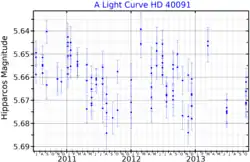HD 40091
HD 40091, also known as HR 2082, is a solitary star[15] located in the southern constellation Columba, the dove. It has an apparent magnitude of 5.54,[3] making it faintly visible to the naked eye under ideal conditions. Based on parallax measurements from the Gaia spacecraft, the object is estimated to be 501 light years distant.[2] However, it is rapidly receding with a high heliocentric radial velocity of 114 km/s.[7]
| Observation data Epoch J2000.0 Equinox J2000.0 (ICRS) | |
|---|---|
| Constellation | Columba |
| Right ascension | 05h 54m 52.48300s[2] |
| Declination | −39° 57′ 28.2946″[2] |
| Apparent magnitude (V) | 5.54±0.01[3] |
| Characteristics | |
| Spectral type | M0 III[4] |
| U−B color index | +1.85[5] |
| B−V color index | +1.51[5] |
| Variable type | suspected[6] |
| Astrometry | |
| Radial velocity (Rv) | 114±2[7] km/s |
| Proper motion (μ) | RA: −11.977 mas/yr[2] Dec.: +21.203 mas/yr[2] |
| Parallax (π) | 6.5078 ± 0.1112 mas[2] |
| Distance | 501 ± 9 ly (154 ± 3 pc) |
| Absolute magnitude (MV) | −0.4[8] |
| Details | |
| Mass | 1.21[9] M☉ |
| Radius | 52.43[10] R☉ |
| Luminosity | 392[11] L☉ |
| Surface gravity (log g) | 1.31[9] cgs |
| Temperature | 3,969±122[12] K |
| Metallicity [Fe/H] | +0.14[9] dex |
| Other designations | |
| Database references | |
| SIMBAD | data |
This is an evolved red giant with a stellar classification of M0 III.[4] It has 121% the mass of the Sun[9] but has expanded to 52.43 times its girth.[10] It radiates 392 times the luminosity of the Sun[11] from its enlarged photosphere at an effective temperature of 3,969 K,[12] giving it a red hue. HD 40091 is slightly metal enriched, having an iron abundance 38% above solar levels. [9]
HD 40091 is found to vary between 5.64 and 5.68 in the Hipparcos passband, but it is not confirmed to be a variable star. Therefore, it is catalogued in the GCVS as a suspected variable.[6]
References
- "/ftp/cats/more/HIP/cdroms/cats". Centre de Données astronomiques de Strasbourg. Strasbourg astronomical Data Center. Retrieved 15 October 2022.
- Vallenari, A.; et al. (Gaia collaboration) (2023). "Gaia Data Release 3. Summary of the content and survey properties". Astronomy and Astrophysics. 674: A1. arXiv:2208.00211. Bibcode:2023A&A...674A...1G. doi:10.1051/0004-6361/202243940. S2CID 244398875. Gaia DR3 record for this source at VizieR.
- Høg, E.; Fabricius, C.; Makarov, V. V.; Urban, S.; Corbin, T.; Wycoff, G.; Bastian, U.; Schwekendiek, P.; Wicenec, A. (March 2000). "The Tycho-2 catalogue of the 2.5 million brightest stars". Astronomy and Astrophysics. 355: L27–L30. Bibcode:2000A&A...355L..27H. ISSN 0004-6361.
- Houk, N. (1982). Michigan Catalogue of Two-dimensional Spectral Types for the HD stars. Volume_3. Declinations −40° to −26°. Bibcode:1982mcts.book.....H.
- Oja, T. (1970). "UBV-Fotometri danska Tel (ESO)". Private Communication: 0. Bibcode:1970Priv.........0O.
- Samus’, N. N.; Kazarovets, E. V.; Durlevich, O. V.; Kireeva, N. N.; Pastukhova, E. N. (January 2017). "General catalogue of variable stars: Version GCVS 5.1". Astronomy Reports. 61 (1): 80–88. Bibcode:2017ARep...61...80S. doi:10.1134/S1063772917010085. eISSN 1562-6881. ISSN 1063-7729. S2CID 125853869.
- Gontcharov, G. A. (November 2006). "Pulkovo Compilation of Radial Velocities for 35 495 Hipparcos stars in a common system". Astronomy Letters. 32 (11): 759–771. arXiv:1606.08053. Bibcode:2006AstL...32..759G. doi:10.1134/S1063773706110065. eISSN 1562-6873. ISSN 1063-7737. S2CID 119231169.
- Anderson, E.; Francis, Ch. (May 2012). "XHIP: An extended hipparcos compilation". Astronomy Letters. 38 (5): 331–346. arXiv:1108.4971. Bibcode:2012AstL...38..331A. doi:10.1134/S1063773712050015. eISSN 1562-6873. ISSN 1063-7737. S2CID 119257644.
- Anders, F.; et al. (August 2019). "Photo-astrometric distances, extinctions, and astrophysical parameters for Gaia DR2 stars brighter than G = 18". Astronomy & Astrophysics. 628: A94. arXiv:1904.11302. Bibcode:2019A&A...628A..94A. doi:10.1051/0004-6361/201935765. eISSN 1432-0746. ISSN 0004-6361.
- Kervella, Pierre; Arenou, Frédéric; Thévenin, Frédéric (20 December 2021). "Stellar and substellar companions from Gaia EDR3". Astronomy & Astrophysics. 657: A7. arXiv:2109.10912. Bibcode:2022A&A...657A...7K. doi:10.1051/0004-6361/202142146. eISSN 1432-0746. ISSN 0004-6361.
- McDonald, I.; Zijlstra, A. A.; Boyer, M. L. (21 November 2012). "Fundamental parameters and infrared excesses of Hipparcos stars: Parameters and IR excesses from Hipparcos". Monthly Notices of the Royal Astronomical Society. 427 (1): 343–357. arXiv:1208.2037. Bibcode:2012MNRAS.427..343M. doi:10.1111/j.1365-2966.2012.21873.x. ISSN 0035-8711.
- Stassun, Keivan G.; et al. (9 September 2019). "The Revised TESS Input Catalog and Candidate Target List". The Astronomical Journal. 158 (4): 138. arXiv:1905.10694. Bibcode:2019AJ....158..138S. doi:10.3847/1538-3881/ab3467. eISSN 1538-3881. hdl:1721.1/124721. S2CID 166227927.
- Gould, Benjamin Apthorp (1878). "Uranometria Argentina : brillantez y posicion de las estrellas fijas, hasta la septima magnitud, comprendidas dentro de cien grados del polo austral : con atlas". Resultados del Observatorio Nacional Argentino. 1. Bibcode:1879RNAO....1.....G.
- "HD 40091". SIMBAD. Centre de données astronomiques de Strasbourg. Retrieved November 1, 2022.
- Eggleton, P. P.; Tokovinin, A. A. (11 September 2008). "A catalogue of multiplicity among bright stellar systems". Monthly Notices of the Royal Astronomical Society. 389 (2): 869–879. arXiv:0806.2878. Bibcode:2008MNRAS.389..869E. doi:10.1111/j.1365-2966.2008.13596.x. eISSN 1365-2966. ISSN 0035-8711.
